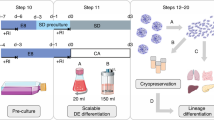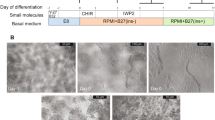Abstract
Mouse embryonic stem (ES) cells are competent for production of all fetal and adult cell types1. However, the utility of ES cells as a developmental model or as a source of defined cell populations for pharmaceutical screening or transplantation is compromised because their differentiation in vitro is poorly controlled2. Specification of primary lineages is not understood and consequently differentiation protocols are empirical, yielding variable and heterogeneous outcomes. Here we report that neither multicellular aggregation3,4 nor coculture5 is necessary for ES cells to commit efficiently to a neural fate. In adherent monoculture, elimination of inductive signals for alternative fates is sufficient for ES cells to develop into neural precursors. This process is not a simple default pathway, however, but requires autocrine fibroblast growth factor (FGF). Using flow cytometry quantitation and recording of individual colonies, we establish that the bulk of ES cells undergo neural conversion. The neural precursors can be purified to homogeneity by fluorescence activated cell sorting (FACS) or drug selection. This system provides a platform for defining the molecular machinery of neural commitment and optimizing the efficiency of neuronal and glial cell production from pluripotent mammalian stem cells.
This is a preview of subscription content, access via your institution
Access options
Subscribe to this journal
Receive 12 print issues and online access
$209.00 per year
only $17.42 per issue
Buy this article
- Purchase on Springer Link
- Instant access to full article PDF
Prices may be subject to local taxes which are calculated during checkout




Similar content being viewed by others
References
Keller, G.M. In vitro differentiation of embryonic stem cells. Curr. Opin. Cell. Biol. 7, 862–869 (1995).
Smith, A.G. Embryo-derived stem cells: of mice and men. Ann. Rev. Cell Dev. Biol. 17, 435–462 (2001).
Bain, G., Kitchens, D., Yao, M., Huettner, J.E. & Gottlieb, D.I. Embryonic stem cells express neuronal properties in vitro. Dev. Biol. 168, 342–357 (1995).
Wiles, M.V. & Johansson, B.M. Embryonic stem cell development in a chemically defined medium. Exp. Cell Res. 247, 241–248 (1999).
Kawasaki, H. et al. Induction of midbrain dopaminergic neurons from ES cells by stromal cell-derived inducing activity. Neuron 28, 31–40 (2000).
Munoz-Sanjuan, I. & Brivanlou, A.H. Neural induction, the default model and embryonic stem cells. Nat. Rev. Neurosci. 3, 271–280 (2002).
Wilson, S.I. & Edlund, T. Neural induction: toward a unifying mechanism. Nat. Neurosci. 4 (Suppl.), 1161–1168 (2001).
Tropepe, V. et al. Direct neural fate specification from embryonic stem cells: a primitive mammalian neural stem cell stage acquired through a default mechanism. Neuron 30, 65–78 (2001).
Wood, H.B. & Episkopou, V. Comparative expression of the mouse Sox1, Sox2 and Sox3 genes from pre-gastrulation to early somite stages. Mech. Dev. 86, 197–201 (1999).
Aubert, J., Dunstan, H., Chambers, I. & Smith, A. Functional gene screening in embryonic stem cells implicates Wnt antagonism in neural differentiation. Nat. Biotechnol. 20, 1240–1245 (2002).
Tucker, K.L., Meyer, M. & Barde, Y.A. Neurotrophins are required for nerve growth during development. Nat. Neurosci. 4, 29–37 (2001).
Lee, S.H., Lumelsky, N., Studer, L., Auerbach, J.M. & McKay, R.D. Efficient generation of midbrain and hindbrain neurons from mouse embryonic stem cells. Nat. Biotechnol. 18, 675–679 (2000).
Niwa, H., Miyazaki, J. & Smith, A.G. Quantitative expression of Oct-3/4 defines differentiation, dedifferentiation or self-renewal of ES cells. Nat. Genet. 24, 372–376 (2000).
Ying, Q.L., Nichols, J., Evans, E.P. & Smith, A.G. Changing potency by spontaneous fusion. Nature 416, 545–548 (2002).
Cebria, F. et al. FGFR-related gene nou-darake restricts brain tissues to the head region of planarians. Nature 419, 620–624 (2002).
Launay, C., Fromentoux, V., Shi, D.L. & Boucaut, J.C. A truncated FGF receptor blocks neural induction by endogenous Xenopus inducers. Development 122, 869–880 (1996).
Streit, A., Berliner, A.J., Papanayotou, C., Sirulnik, A. & Stern, C.D. Initiation of neural induction by FGF signalling before gastrulation. Nature 406, 74–78 (2000).
Wilson, S.I., Graziano, E., Harland, R., Jessell, T.M. & Edlund, T. An early requirement for FGF signalling in the acquisition of neural cell fate in the chick embryo. Curr. Biol. 10, 421–429 (2000).
Mohammadi, M. et al. Structures of the tyrosine kinase domain of fibroblast growth factor receptor in complex with inhibitors. Science 276, 955–960 (1997).
Li, X. et al. Fibroblast growth factor signaling and basement membrane assembly are connected during epithelial morphogenesis of the embryoid body. J. Cell Biol. 153, 811–822 (2001).
Feldman, B., Poueymirou, W., Papaioannou, V.E., DeChiara, T.M. & Goldfarb, M. Requirement of FGF-4 for postimplantation mouse development. Science 267, 246–249 (1995).
Arman, E., Krausz-Haffner, R., Chen, Y., Heath, J.K. & Lonai, P. Targeted disruption of fibroblast growth factor (FGF) receptor 2 suggests a role for FGF signaling in pregastrulation mammalian development. Proc. Natl. Acad. Sci. USA 95, 5082–5087 (1998).
Nichols, J., Chambers, I., Taga, T. & Smith, A.G. Physiological rationale for responsiveness of mouse epiblast and embryonic stem cells to gp130 cytokines. Development 128, 2333–2339 (2001).
Acknowledgements
We thank John Heath for the DN-FGFR construct. We are grateful to Steve le Moenic for flow cytometry support and to Alexander Medvinsky and Josh Brickman for comments on the manuscript. This research is supported by the International Human Frontiers Science Program Organisation, and by the Medical Research Council and the Biotechnology and Biological Sciences Research Council of the United Kingdom.
Author information
Authors and Affiliations
Corresponding author
Ethics declarations
Competing interests
A.S. is a scientific advisor to Stem Cell Sciences Ltd. and holds nonvoting equity in the company. Stem Cell Sciences funds research in the laboratory and has patents granted and pending on technology used in this manuscript.
Supplementary information
Rights and permissions
About this article
Cite this article
Ying, QL., Stavridis, M., Griffiths, D. et al. Conversion of embryonic stem cells into neuroectodermal precursors in adherent monoculture. Nat Biotechnol 21, 183–186 (2003). https://doi.org/10.1038/nbt780
Received:
Accepted:
Published:
Issue Date:
DOI: https://doi.org/10.1038/nbt780
This article is cited by
-
DNA methylation restricts coordinated germline and neural fates in embryonic stem cell differentiation
Nature Structural & Molecular Biology (2024)
-
Loss of Dip2b leads to abnormal neural differentiation from mESCs
Stem Cell Research & Therapy (2023)
-
A new era of stem cell and developmental biology: from blastoids to synthetic embryos and beyond
Experimental & Molecular Medicine (2023)
-
Multiplex-GAM: genome-wide identification of chromatin contacts yields insights overlooked by Hi-C
Nature Methods (2023)
-
Functional dissection of PRC1 subunits RYBP and YAF2 during neural differentiation of embryonic stem cells
Nature Communications (2023)



